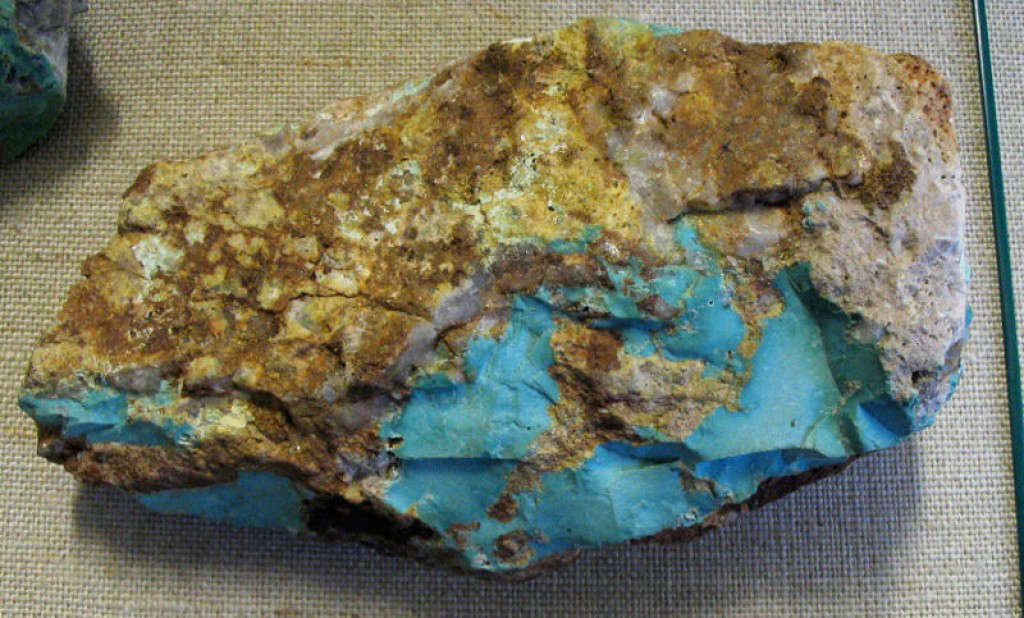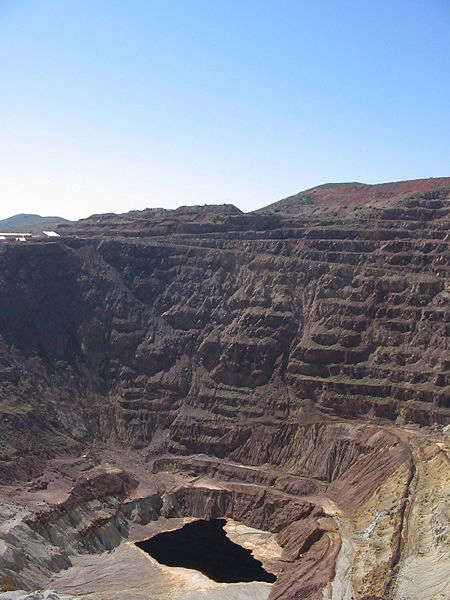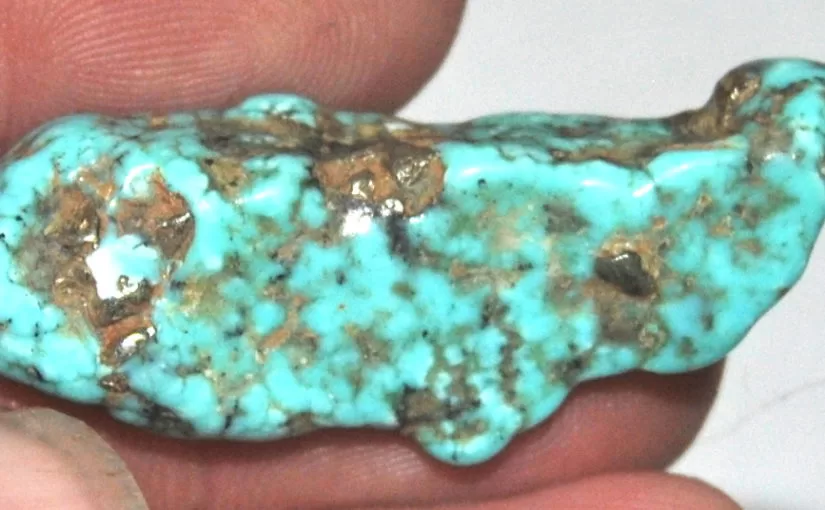
Source: Aramgutang-public domain-via Wikipedia
Fun Fact
Arizona’s official neckwear is the Bola Tie (sometimes referred to as a Bolo Tie) which is made using braided cord or leather with decorative metal ends. The cord is worn in a similar fashion as a conventional men’s tie except that the cord is secured with an ornamental clasp or slide which is often made with Sterling silver and Turquoise.
Official Gemstone of Arizona
Turquoise has been Arizona’s official gemstone since 1974. Turquoise has been used by the Southwestern United States Native Americans since before the birth of Christ.
Although turquoise can be found in several western states in the U.S. including California, New Mexico, Nevada, and Colorado, Arizona’s turquoise is currently the most important producer of turquoise in terms of the value of production according to minerals.usgs.gov.
The most desirable turquoise is said to have a strong sky to “robin’s egg” blue color. A good example of this color is the turquoise that comes from the Sleeping Beauty Mine in Arizona.
While this unblemished blue turquoise is very desirable, turquoise with a “spiderweb matrix” is highly sought after by collectors of Arizona Turquoise.
Turquoise Mountain & Birdseye Turquoise
Both Birdseye and Turquoise Mountain Turquoise come from the same mine near Kingman, Arizona about a ¼ mile from Ithaca Peak.
The mine closed in the 1980s however during my recent visits to Colbaugh Processing I found the material is still available for purchase today.
Birdseye Turquoise has a unique darker blue matrix surrounding the beautiful light blue turquoise.
Birdseye Turquoise was offered stabilized, but natural color by Colbaugh Processing at $450.00/lb at the time this article was written.
Blue Bird Turquoise
This is probably the most secretive turquoise mine in Arizona. Very little is known as to the exact location of the mine. Some say it’s a small mine in Cochise County while others say it’s part of the Sleeping Beauty Mining operation. Wherever it comes from, the mine is closed and is no longer producing turquoise.
This mine produces very hard turquoise with various types of matrix.
Note: There is another turquoise from Nevada called Little Blue Bird Turquoise that is often mistaken for Blue Bird Turquoise due to the name similarities.
Bisbee Turquoise

Cornellrockey-CC-BY-SA-2.5 via Wikimedia Commons
Bisbee Turquoise is one of the most highly sought after types of turquoise that comes from the Southwestern United States.
Marketed today under the trademarked name “Bisbee Blue”, Bisbee Turquoise has a unique brilliant blue color with reddish-brown or chocolate color matrix. The colors and patterns that are found in Bisbee Turquoise are unique and can be found nowhere else in the world.
The majority of Bisbee Turquoise came from the mine known as the Lavendar Pit. (Not spelled Lavender)
The majority of the turquoise found at the Lavendar Pit was hauled off and dumped as waste material before its beauty was discovered. Small amounts of the turquoise were “lunch boxed” out by miners that recognized it’s beauty.
As this material reached the public it was recognized as some of the finest turquoises ever discovered and it became highly sought after by collectors and silversmiths.
In the last few years, tourists have been allowed to collect small amounts of turquoise from the surrounding dumps. The event occurs on Father’s Day weekend when a small portion of the dumps are turned over and for a small fee, a small number of visitors are allowed to try to find the elusive turquoise as well as other copper minerals.
Castle Dome Turquoise
Closed since the early 1970s, the Pinto Valley Mine, originally called Castle Dome Mine, was at one time one of Arizona’s largest producing turquoise mines.
Most of the turquoise from the mine was low quality and required stabilization. High-quality Castle Dome Turquoise is extremely rare.
The mine is located approximately 30 miles away from the famous Sleeping Beauty Mine near Globe, Arizona.
Castle Dome Turquoise is similar in appearance to Sleeping Beauty Turquoise except it has a more vibrant blue color had has some matrix in it.
Since the closing of the mine, the site has been reclaimed by filling the mine and replanting native vegetation.
Morenci Turquoise
Although Morenci Turquoise varies with many different shades of blue and with many different types of matrix patterns and colors, it is most famous for the iron pyrite or “fools gold” that is often found in the turquoise.
For many years the rights to Morenci Turquoise were leased out to private companies. These leases have expired and turquoise mining at Morenci is no longer allowed.
Kingman Turquoise
Kingman Turquoise (Mineral Peak Mine) is some of the world’s most sought-after turquoise. It occurs in many colors of blue and green with hard untreated medium to dark blue turquoise sometimes with pieces of pyrite being the most sought after by collectors. Natural untreated Kingman Turquoise is very rare.
Kingman Turquoise is marketed under the names Kingman, Ithaca Peak, and Turquoise Mountain Turquoise.
Ithaca Peak Turquoise
Ithaca Peak produced some of the finest turquoises in the United States.
The nearby Turquoise Mountain is now the main focus of turquoise in the area making high-quality Ithaca Peak Turquoise very expensive if it ever becomes available for sale from old collections.
Sleeping Beauty Turquoise
A favorite of the Zuni Pueblo silversmiths, this almost matrix-free turquoise has a solid, light blue color.
The Sleeping Beauty mine is located just outside of Globe, Arizona.
This mine has produced large quantities of turquoise however natural untreated Sleeping Beauty Turquoise is quite rare and highly prized.
Due to the lack of veining and the bright robin’s egg blue color of this amazing turquoise, it is often faked with reconstituted turquoise or even plastic.
Use Caution When Purchasing Turquoise
Fake turquoise has been produced for many years. Rocks may be dyed blue to make it appear to be real turquoise.
One of the most common types of rock used to make fake turquoise is Howlite. Howlite has veins running through it that looks very much like the veins that run through some turquoise. The mineral is quite porous making it easy to get dye all the way through the stone. Once Howlite is dyed it looks very much like turquoise and can be difficult to spot even by those with a trained eye for turquoise.
Another mineral commonly used to fake turquoise is Magnesite nodules which once dyed look very much like natural turquoise nuggets.
Turquoise powder or cuttings are often crushed and added to a plastic resin to create what appears to be natural turquoise. Veins are often added to this reconstituted turquoise to make it appear more natural.
Reconstituted turquoise and plastic look-alikes are often used in inexpensive jewelry.
Imitation Turquoise
Besides treated natural stones such as Howlite, many other materials are used to imitate genuine turquoise. Glass, plastic, and ceramics have all been used to imitate turquoise. Recently Polymer Clay has been a popular method to imitate turquoise.
Turquoise Treatments
Real turquoise is often treated. The most common treatment is known as stabilization. The majority of turquoise that is mined is too soft to be used in jewelry.
Stabilization helps make the turquoise strong enough to be cut and used in jewelry. Stabilization also helps protect the turquoise from sweat, lotions and sprays that may come in contact with the turquoise during normal everyday use in jewelry.
Another treatment is Color Enhancement. This technique uses dye to make poor-quality turquoise look more pleasing.
Wax is sometimes used to help make the surface of turquoise look more pleasing. This is especially common in inexpensive Chinese Turquoise.

